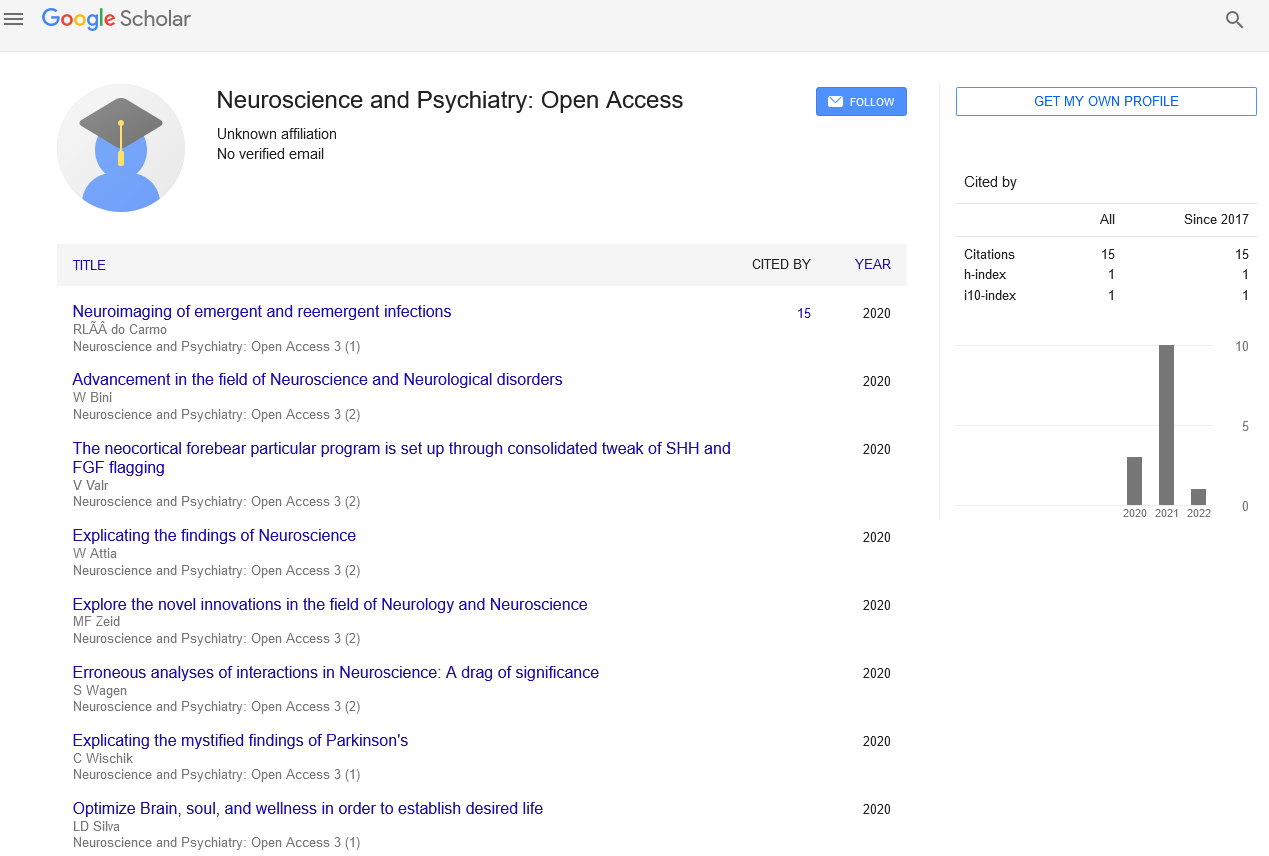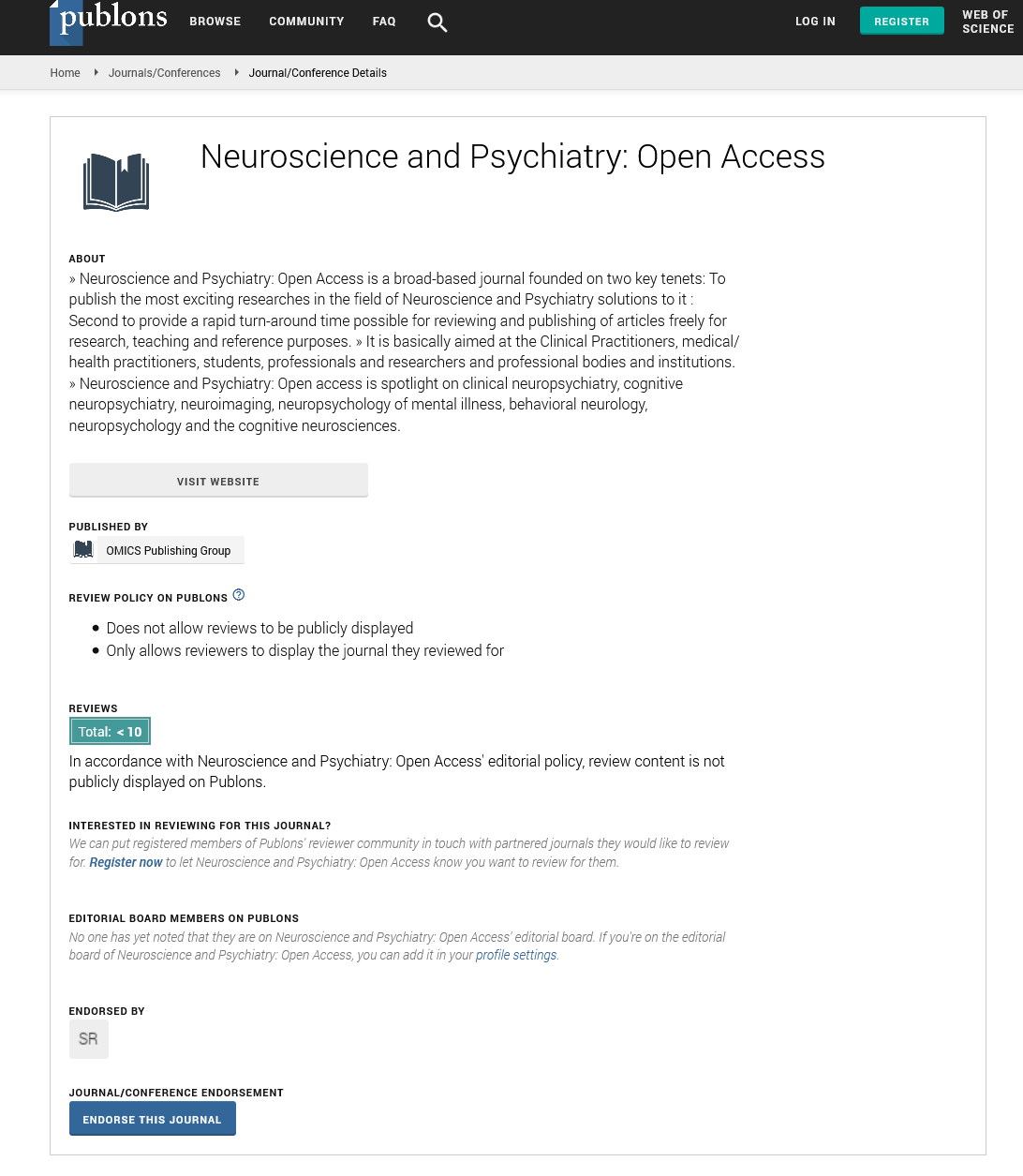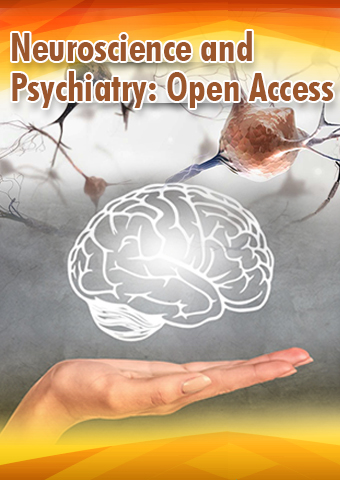Short Article - Neuroscience and Psychiatry: Open Access (2018) Volume 1, Issue 2
Neurocysticercosis: A Narrative Review
Shaikha D Al-Shokri, Mohammed I Danjuma, Abdelâ€ÂNaser Elzouki
Hamad Medical Corporation, Qatar
Abstract
Introduction:
Neurocysticercosis (NCC) is a central nervous system (CNS) infection caused by parasitic infections, Taenia saginata, and, most commonly, Taenia Solium.1 The infection leads to neurological sequelae such as seizure, neurological deficits, or altered mental status.1
Epidemiology:
NCC is one of the most common infections in developing countries. According to the World Health Organization (WHO), NCC has affected around fifty million people and caused 50,000 deaths in the 1990s.2 Besides, NCC is the leading cause of epilepsy in low-income countries; around 29% of epilepsy patients in the endemic areas suffer from NCC infection.1, 2
Also, there is a financial impact of the disease on the health system. In the United States, it is estimated that more than 2,300 hospitalizations happen annually, with a total of $37,600 per patient. Being a severe illness, the WHO and the center of disease and control prevention (CDC) listed NCC as one of the five neglected infections worldwide.1, 2
The estimated prevalence in endemic areas in Latin America, Asia, and sub-Saharan Africa, is from 13% to 54%.3 Several proposed theories explain the lack of definitive prevalence of the disease. First, there is a lack of adequate case definition in the literature. Some studies refer to radiological changes such as calcification on the computed tomography (CT) while others relied on serum immunology, both of which do not necessarily indicate active disease.4 Second, most of the patients are asymptomatic and are diagnosed based on brain calcifications, which wrongly overestimate the prevalence.3,4 Finally, most of the literature studies are community-based studies in the endemic areas where they lack accurate diagnostic tools.4
Life Cycle:
Taenia solium is a parasite that transmits to human through pigs, which serve as an intermediate host. Humans serve as intermediate hosts, as well. The infection happens through direct ingestion of T. solium eggs or direct human-to-human transmission via the faeco-oral route.5,6
The cycle begins when the host ingests the T. solium eggs by the ingestion of infected human feces. Then the larval stage develops in the host muscles. As human consumes infected pork meat, they develop intestinal stage, during which the T. solium larvae grow within four months. The larvae then grow into adult worms, become gravid, and release eggs. The eggs then pass from the host into feces. Pigs or humans get infected by eggs or gravid worms’ consumption. The eggs penetrate the intestinal wall and spread to the muscles and other organs, forming cysticerci. Mainly, if cysticerci migrate to the CNS, then neurocysticercosis develops.5,6
Types of Neurocysticercosis:
The NCC is classified as extra-parenchymal and a parenchymal form, based on the location of the parasite.5 Extra-parenchymal neurocysticercosis (EP-NCC) occurs when the larvae migrate to the subarachnoidal and intra-ventricular spaces, triggering an inflammatory pattern.7 Additionally, cysticerci may obstruct the CNS flow, or invade the choroid plexus, leptomeninges, arachnoid space, and pia mater. Patients present with signs and symptoms of intracranial hypertension and hydrocephalus. Usually, the course of the disease is malignant, with severe morbidities and mortality.5,7
Intra-parenchymal neurocysticercosis (IP-NCC) happens as cysticerci develop in the cerebral parenchyma, mainly at the white-grey junction.8 The cerebral cysticerci modulate the immune-regulated process, suppressing the host defense mechanism. 8 With the death of the parasite, the parasitic antigens are exposed, leading to neuronal damage and granuloma formation. Patients usually present with self-limiting manifestations, such as seizure and neurological deficits. Pyramidal manifestations are the most common deficits compared to sensory and extrapyramidal manifestations; the severity of the deficits depends on the location, size, and number of the parasites. IP-NCC ensues a better prognosis.7
Neuroimaging of Neurocysticercosis:
Neuroimaging such as computed tomography (CT) scan and magnetic resonance imaging (MRI) are used to detect NCC lesions. MRI is an excellent modality in visualizing viable parasites, cysticerci as ring-enhancing lesions surrounded by edema. However, calcified lesions may be missed and usually better visualized in the CT scans.5
There are four stages of NCC in neuroimages. The vesicular stage is the first stage characterized by a single iso-dense cyst surrounding a high-density lesion, representing the scolex, the anterior segment of the tapeworm. At this stage, there is a minimal inflammatory reaction. In the second stage, the formation of gelatinous fluid-filled cysts with profound inflammation is characteristic. This appears in the CT scan as a ring-enhancing lesion. In the nodular stage, the scolex degenerates into granules, and the cysticerci walls are replaced by necrosis and lymphoid nodules. The final stage is known as the nodular calcified stage, when NCC lesions become calcified and are filled with collagenous tissues. This stage is a nonactive stage; however, recurrent seizures usually happen more frequently. It is postulated that perilesional gliosis at this stage forms epileptogenic foci, which trigger seizures.9
In the EP-NCC, it used to be challenging to detect the parasite in the CSF, where it appears as iso-intense lesions.4 Recently, “3-D MRI sequences, such as fast Imaging Employing Steady State Acquisition (FIESTA), Constructive Interference in SteadyState (CISS) and Spoiled Gradient Recalled Echo (SPGR)” have been introduced recently to detect EP-NCC lesion within the ventricular system and subarachnoid space.4
Serological investigations:
Enzyme-linked immunosorbent assay (ELISA) is a test used to identify the antibodies against tapeworm antigen.4, 5 It is a sensitive and specific tool in high burden disease with multiple cysticerci. However, the sensitivity and specificity are reduced in detecting single NCC or calcified lesions.4
Another serological useful diagnostic tool is Enzyme-linked immune-electrotransfer blot (ETIB) assay. The sensitivity and specificity are high, especially in detecting active disease. ELISA and ETIB have been used in CNS samples, and the sensitivity and specificity of both serum and CSF are the same.5
Other new modalities have been described recently, such as sampling CSF by polymerase chain reaction (PCR) to detect EPNCC.10
Treatment of neurocysticercosis:
Treating patients with NCC is individualized, depending on the disease severity, parasite location, and clinical presentation. Treatment options include symptomatic therapy, antihelminthic, and surgery.11
Symptomatic treatment and supportive measures include steroids to reduce the inflammation when there is peri-lesion edema. Dexamethasone and prednisolone are commonly used.5 However, there is no consensus regarding the dose and duration of steroid. Moreover, other supportive therapies include anti-epileptic drugs (AEDs) for seizure, analgesia for headache, and mannitol for raised intracranial pressure. Like steroids, there is no preference in using a specific AED, and the duration remains unknown.5
Anti-helminthic drugs (AHDs), such as albendazole and praziquantel, are used for IP-NCC viable cysts. A combination of both albendazole and praziquantel is not statistically significant compared to monotherapy.12 However, albendazole is more efficacious in treating viable NCC cysts compared to praziquantel.11 Administration of AHDs increases the risk of seizure due to degenerating of the NCC cysts, leading to brain edema secondary to parasitic antigen-mediated inflammatory response. Therefore, steroid is usually co-administered with the antiparasitic drugs.13
Conclusion:
NCC is a common, yet a neglected disease, worldwide. It is one of the common causes of epilepsy in endemic areas. The prevalence of NCC remains unclear because of the lack of case definition and paucity of well-established literature in resourcelimited areas that are NCC endemic areas. Standard guidelines for diagnostic tests and treatments are lacking. Future researches are needed to explore more diagnostic and treatment options.
References
- Cdc.gov. (2020). CDC - Parasites - Features - Neurocysticercosis CME. [online] Available at: https://www.cdc.gov/parasites/ features/ncc_cme_feature.html [Accessed 19 Feb. 2020].
- Who.int. (2020). Taeniasis/Cysticercosis. [online] Available at: https://www.who.int/news-room/fact-sheets/detail/taeniasiscysticercosis [Accessed 19 Feb. 2020].
- Winkler AS, Richter H. Landscape analysis: management of neurocysticercosis with an emphasis on low- and middleincome countries. Geneva, Switzerland: Commissioned by the World Health Organization; 2015.
- Arturo Carpio, Agnès Fleury, Matthew L. Romo & Ronaldo Abraham (2018) Neurocysticercosis: the good, the bad, and the missing, Expert Review of Neurotherapeutics, 18:4, 289-301, DOI: 10.1080/14737175.2018.1451328
- Al-Saeed WM, Oleiwi Al-Kuraishi AH, Dahash SL, Al-Gareeb AI, Alkuraishy HM. Neurocysticercosis: A new concept and insight into basic and future pharmacotherapy. J Pak Med Assoc. 2019;69(Suppl 3)(8):S113-S118.
- Praet N, Kanobana K, Kabwe C, Maketa V, Lukanu P, Lutumba P, et al. Taenia solium cysticercosis in the Democratic Republic of Congo: how does pork trade affect the transmission of the parasite? PLoSNegl Trop Dis 2010;4:e817.
- Mao DH, Gao S, Li YM. [Imaging characteristics of different types of cerebral cysticercosis]. ZhongguoXue Xi Garcia HH, Del Brutto OH; Cysticercosis Working Group in Peru. Neurocysticercosis: updated concepts about an old disease. Lancet Neurol 2005;4:653-61.
- Zhao, Jing-Long, et al. “Imaging Spectrum of Neurocysticercosis.” Radiology of Infectious Diseases, vol. 1, no. 2, Mar. 2015, pp. 94–102, 10.1016/j.jrid.2014.12.001.
- Carpio A, Campoverde A, Romo ML, et al. Validity of a PCR assay in CSF for the diagnosis of neurocysticercosis. Neurol Neuroimmunol Neuroinflamm. 2017;4:e324.
- 1 Carpio A, Kelvin E, Bagiella E, et al.; for the Ecuadorian Neurocysticercosis Group. The effects of albendazole treatment on neurocysticercosis: a randomized controlled trial. J Neurol Neurosurg Psychiatry. 2008; 79:1050–1055.
- Garcia HH, Gonzales I, Lescano AG, et al.; for the Cysticercosis Working Group in Peru. Efficacy of combined antiparasitic therapy with praziquantel and albendazole for neurocysticercosis: a dou- ble-blind, randomised controlled trial. Lancet Infect Dis. 2014; 14:687–695.
- Garcia HH, Del Brutto OH; Cysticercosis Working Group in Peru. Antiparasitic treatment of neurocysticercosis - The effect of cyst destruction in seizure evolution. Epilepsy Behav2017; 76:158-62.


